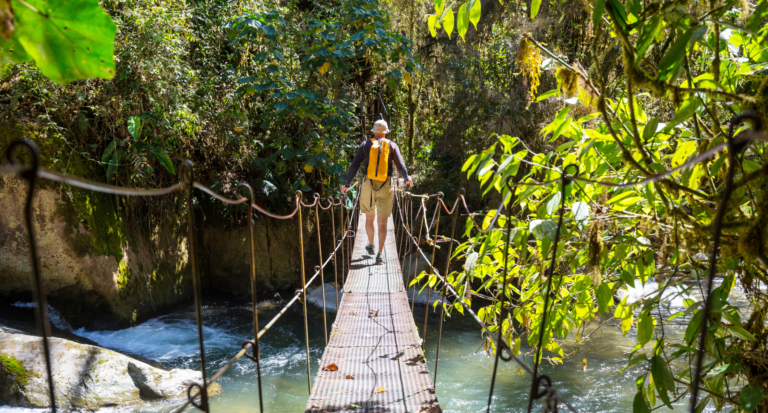One-Week Costa Rica Itinerary: What's Covered
Seven days works best with two complementary regions instead of four rushed destinations. Costa Rica’s mountains make distances deceptive—add 30% to drive times. Choose San José airport for La Fortuna/Monteverde or Manuel Antonio, or Liberia for Guanacaste beaches. A 4×4 handles all routes comfortably, especially Monteverde’s unpaved sections.
Quick Facts:
- Two regions beat four rushed stops for wildlife and relaxation
- Dry season brings crowds; green season offers 20-40% discounts
- La Fortuna to Monteverde takes 3 hours on winding mountain roads
- Book Monteverde lodges 2-3 months ahead for the dry season
- Visit Manuel Antonio by 7 AM to avoid crowds
Top 3 Routes:
- Adventure Circuit – La Fortuna (3 nights) + Monteverde (3 nights) for volcanoes and cloud forests
- Beach & Wildlife – Manuel Antonio (4 nights) + Arenal (2 nights), perfect for families
- Guanacaste Explorer – Tamarindo (3 nights) + Rincón de la Vieja (2 nights) for beaches and adventure
Start drives 8-9 AM to arrive by lunch. Check weather patterns for your travel dates.
If you need any help with a Costa Rica car rental, contact us now!
Planning a week in Costa Rica? You’re not alone in wondering how to fit this incredibly diverse country into just seven days. The good news is that a week gives you enough time to experience Costa Rica’s highlights without feeling like you’re constantly packing and unpacking.
The key isn’t trying to see everything—it’s choosing the right combination of experiences that complement each other geographically and logistically. After helping thousands of travelers navigate this exact challenge, I’ve learned what actually works for a memorable week versus what leaves you exhausted.

Which Route Actually Works for First-Time Visitors?
Most first-timers make the same mistake: they try to cram in beaches, volcanoes, cloud forests, and wildlife viewing across four different regions. This turns your vacation into a transportation marathon rather than an experience.
The smart approach? Pick two regions that flow naturally together and explore them properly. You’ll see more, stress less, and actually have time to enjoy the moments that make Costa Rica special.
Here are the three most successful one-week combinations for different travel styles:
Want Volcanoes and Cloud Forests? Which Northern Route Works Best?
- Best for: Active travelers who want volcanoes, hot springs, and cloud forests
- Base locations: La Fortuna (3 nights) + Monteverde (3 nights)
- Driving time between destinations: 3 hours
Looking for Beaches Plus Wildlife? How Does the Central Route Compare?
- Best for: Families and travelers who want both relaxation and nature
- Base locations: Manuel Antonio (4 nights) + Arenal (2 nights)
- Driving time between destinations: 2.5 hours
Prefer Pure Beach Time? Why Consider the Northwestern Route?
- Best for: Beach lovers with some adventure thrown in
- Base locations: Tamarindo (3 nights) + Rincón de la Vieja area (2 nights) + Gulf of Papagayo (1 night)
- Airport: Fly into Liberia (LIR) instead of San José
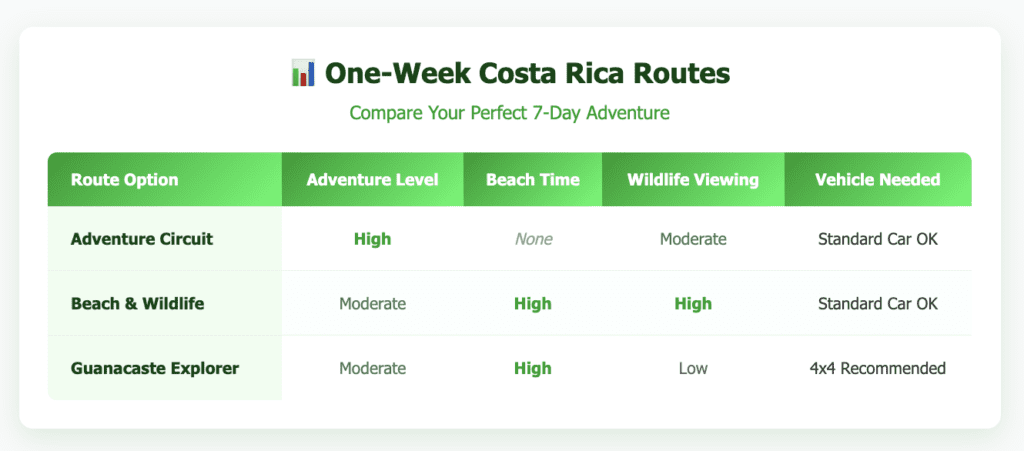
What Should You Know About Transportation Timing?
Costa Rica’s mountainous terrain means distances that look short on a map take longer than expected. Factor in stops for photos, bathroom breaks, and the occasional cow in the road, and you’ll want to add 30% to any estimated drive time.
Morning departures work best. Leave between 8-9 AM to arrive at your next destination by lunch, giving you the afternoon to settle in and explore. Afternoon drivers often hit traffic around San José or get caught in daily rain showers during green season (May-November).
For the routes above, here’s what the driving actually looks like:
La Fortuna to Monteverde: The 3-hour drive winds through mountains with spectacular valley views. The last 45 minutes involves unpaved roads—doable in a standard car during dry season, but a 4×4 makes it much more comfortable.
San José to Manuel Antonio: This 2.5-hour route follows well-maintained highways most of the way. The final stretch into Manuel Antonio involves some steep, winding roads with incredible Pacific views.
Within Guanacaste: Distances are shorter here, with most destinations 1-2 hours apart on relatively flat, well-maintained roads.
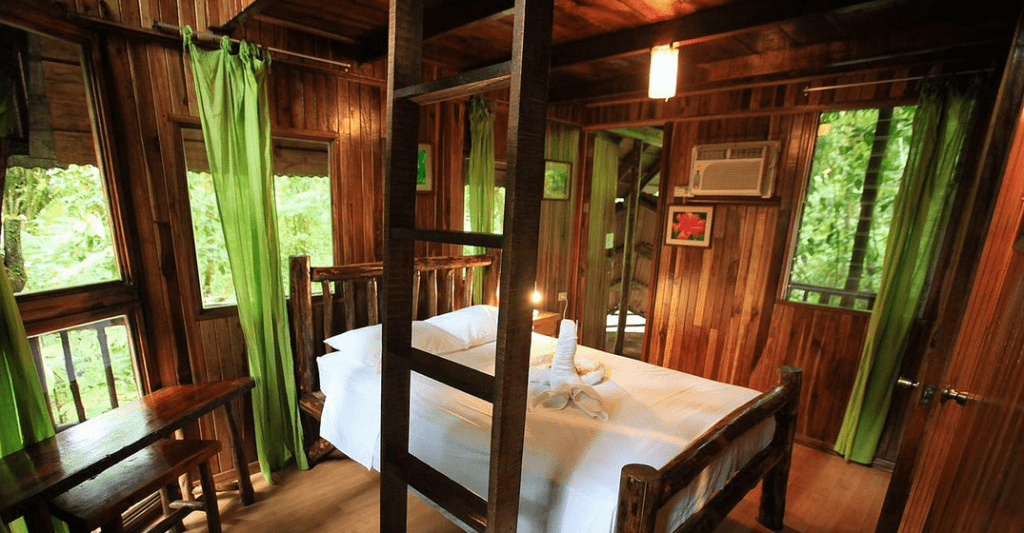
Where Should You Base Yourself for Maximum Access?
Your accommodation choice impacts everything from daily activity options to restaurant selection and evening entertainment. Here’s what works best for each route:
Where Should You Stay Near the Arenal Volcano?
La Fortuna town sits just 7km from Arenal Volcano, putting you within 30 minutes of hot springs, hanging bridges, and adventure tours. The town itself offers plenty of restaurants and services, but staying closer to the volcano gives you better views and easier access to activities.
Insider tip: Book accommodations with volcano views on the north or west side of town. These rooms cost 20-30% more but the sunset views of Arenal’s perfect cone make it worthwhile.
Which Monteverde Area Should You Pick?
Monteverde’s accommodations spread across different elevations, affecting both your cloud forest experience and activity access. Properties in Santa Elena town offer more restaurant options and lower prices. Hotels closer to the cloud forest reserves cost more but put you in the heart of the ecosystem.
What most people don’t realize: The higher elevation properties (above 1,400m) get significantly cooler at night. Pack layers even if you’re visiting during the dry season.
How Do You Choose Between Beach Access and Convenience?
Manuel Antonio offers two distinct areas: the hillside with spectacular ocean views but requiring 10-15 minute drives to beaches, or beachfront properties with direct sand access but limited restaurant options within walking distance.
Local insight: Staying mid-hill gives you the best of both worlds—ocean views, reasonable prices, and 5-minute drives to multiple beaches and the national park entrance.
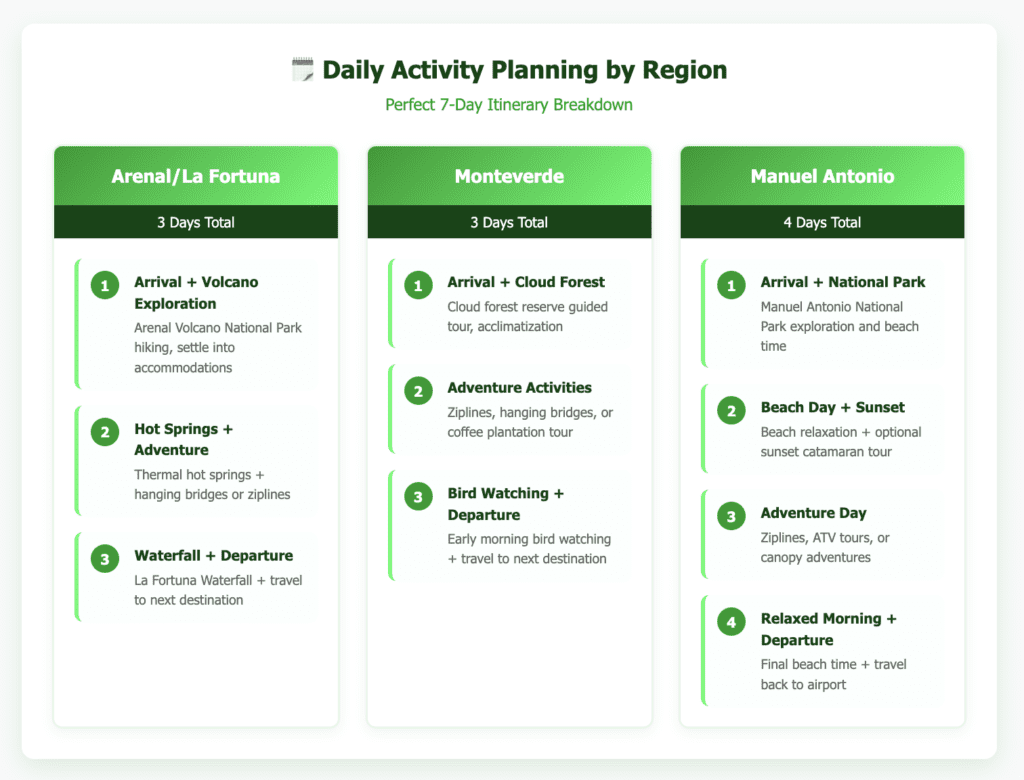
Which Airport Makes More Sense for Your Route?
Your airport choice affects both flight costs and ground transportation logistics significantly. Here’s when each makes sense:
Choose San José (SJO) if you’re doing:
- Adventure Circuit (La Fortuna + Monteverde)
- Beach & Wildlife Combo (Manuel Antonio + Arenal)
- Any itinerary involving the Central Valley or Caribbean coast
Choose Liberia (LIR) if you’re doing:
- Guanacaste Explorer route
- Pure beach vacation in northwestern Costa Rica
- Any itinerary focused on Tamarindo, Peninsula Papagayo, or Rincón de la Vieja
Budget consideration: Flights into Liberia often cost $100-200 more per person than San José, but you’ll save 2-3 hours of driving time if your destinations are in Guanacaste.
For detailed airport comparison and transportation options, check our guide on Choosing the Right Costa Rica Airport.
What About Vehicle Requirements for Each Route?
Costa Rica’s diverse terrain means your vehicle choice directly impacts which destinations you can comfortably access and how much you’ll enjoy the drive.
Standard car sufficient for:
- San José to Manuel Antonio route
- Most of La Fortuna area (volcano viewing, hot springs, main attractions)
- Main Guanacaste beach towns during dry season
4×4 recommended for:
- La Fortuna to Monteverde route (especially green season)
- Any Monteverde cloud forest accommodations
- Remote Guanacaste beaches like Playa Grande or hidden spots
- Green season travel anywhere outside main highways
The reality about 4x4s: Even if the road technically doesn’t require one, the extra ground clearance and traction make mountain drives significantly more comfortable and confident. If your budget allows, the 4×4 upgrade eliminates stress and opens up accommodation options you might otherwise skip.
At Vamos, our most popular choice for one-week Costa Rica trips is the 4×4 SUV because it handles everything from beach parking to mountain roads without worrying about road conditions or weather changes.

How Do You Handle Packing for Multiple Climates?
One week in Costa Rica can include beach temperatures of 90°F (32°C) and cloud forest evenings at 55°F (13°C). The key is layering rather than overpacking.
Essential items for every route:
- Quick-dry clothing (humidity makes cotton miserable)
- Light rain jacket (even dry season gets occasional showers)
- Comfortable walking shoes with good grip
- Flip-flops or sandals for beaches and hot springs
- Insect repellent with DEET or picaridin
- Reef-safe sunscreen (SPF 30+ minimum)
For mountain destinations (Arenal, Monteverde):
- Light fleece or sweater for evenings
- Long pants (bugs and cooler temperatures)
- Closed-toe shoes for hiking
For beach destinations:
- Swimwear (pack at least two sets)
- Lightweight cover-ups
- Water shoes for rocky beaches
- Light long sleeves for sun protection
What’s the Realistic Budget for Each Route?
Understanding costs helps you plan appropriately and avoid surprises. Here’s what a week actually costs per couple, including accommodation, food, activities, and transportation:
Budget travelers: $1,200-1,800 total
- Hostels or basic hotels
- Local sodas (restaurants) for most meals
- Self-guided hikes and free beaches
- Shared shuttle transportation
Mid-range travelers: $2,200-3,200 total
- Standard hotels or boutique properties
- Mix of local and tourist restaurants
- 2-3 guided tours or adventure activities
- Rental car for flexibility
Luxury travelers: $4,000+ total
- Upscale resorts or luxury ecolodges
- Fine dining and resort meals
- Private guides and premium activities
- 4×4 rental with full insurance coverage
Biggest budget impacts: Accommodation choice, activity selection, and transportation method. A mid-range hotel costs 3x more than a hostel, but a luxury ecolodge costs 5x more than mid-range.
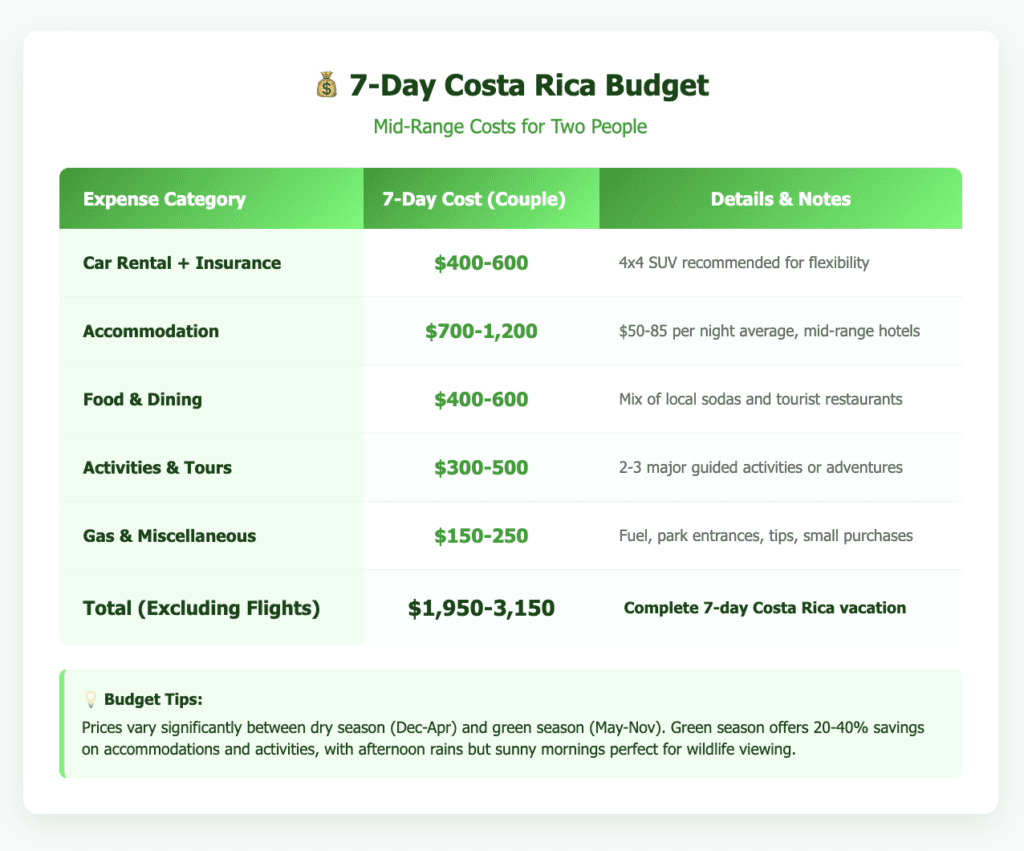
When Should You Visit for Best Weather and Crowds?
Costa Rica has two distinct seasons that dramatically affect your experience, prices, and activity availability.
Dry season (December-April):
- Minimal rainfall, especially January-March
- Higher prices and larger crowds
- Best for photography and consistent outdoor activities
- Book accommodations 2-3 months ahead
Green season (May-November):
- Daily afternoon showers, sunny mornings
- Lower prices (20-40% discounts common)
- Lush, vibrant landscapes
- More flexible booking, but some remote lodges close
Sweet spot timing: Late November and early December offer dry season weather with green season prices, while September-October provides the lowest crowds but highest rainfall.
For detailed seasonal planning, our Costa Rica Weather Guide breaks down each month by region.
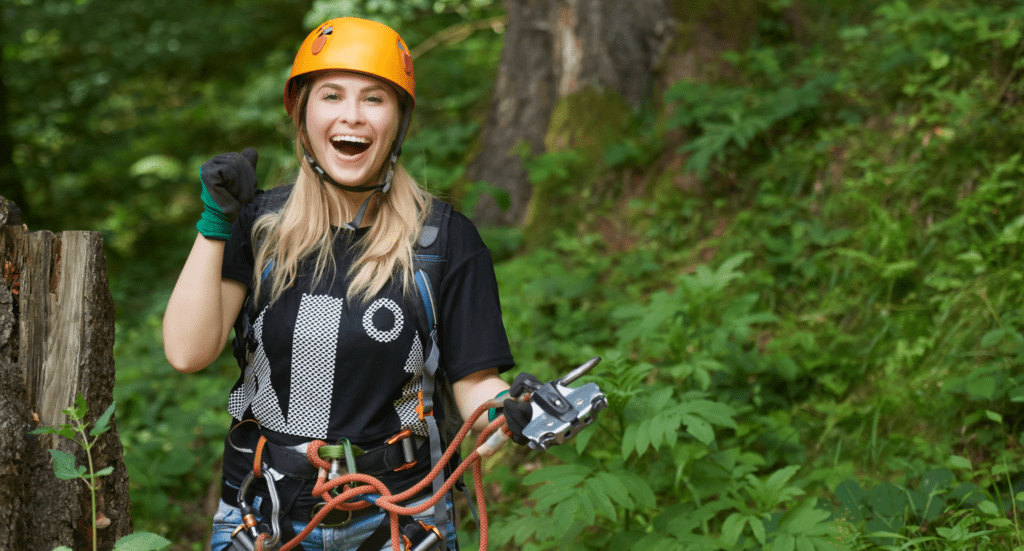
What Are the Must-Do Activities That Actually Matter?
Skip the generic “must-do” lists and focus on experiences that you can’t replicate elsewhere. Here’s what makes Costa Rica unique:
Wildlife encounters that deliver:
- Early morning guided hike in Manuel Antonio (sloth and monkey sightings almost guaranteed)
- Night walk in Monteverde cloud forest (totally different ecosystem after dark)
- Hot springs with volcano views in Arenal area (therapeutic and scenic)
Adventure activities worth the splurge:
- Zipline canopy tour through cloud forest canopy
- White-water rafting on Pacuare River (world-class rapids through pristine rainforest)
- Sunset catamaran trip from Manuel Antonio (dolphins, snorkeling, open bar)
Cultural experiences locals recommend:
- Coffee farm tour with cupping session (learn why Costa Rican coffee is special)
- Traditional meal at a family-run soda (authentic flavors, friendly prices)
- Local farmers market (Saturdays in most towns, incredible fresh produce)
How Do You Avoid Common First-Timer Mistakes?
Mistake 1: Underestimating drive times
Add 30% to any estimated travel time. Mountain roads, photo stops, and traffic around San José regularly extend journeys.
Mistake 2: Overpacking destinations
Two well-chosen regions beat four rushed stops every time. You’ll have better wildlife sightings, less packing stress, and actual time to enjoy each place.
Mistake 3: Ignoring seasonal realities
Green season afternoon rains aren’t suggestions—plan morning activities and indoor afternoon options. Dry season crowds at popular spots are real—visit Manuel Antonio National Park by 7 AM or accept the masses.
Mistake 4: Skipping advance reservations
Popular restaurants in tourist areas fill up, especially on weekends during the dry season. Hot springs, canopy tours, and rental cars book out during peak periods.
Mistake 5: Bringing the wrong shoes
You’ll walk on wet rocks, muddy trails, sandy beaches, and possibly unpaved roads all in the same day. Comfortable, quick-dry shoes with good traction are essential.

Ready to Book? What Are Your Next Steps?
Here’s your action plan for making this one-week Costa Rica adventure happen:
- Choose your route: Pick one of the three options based on your priorities—adventure, beaches, or wildlife.
- Book flights early: Compare San José vs. Liberia based on your chosen route. Book 6-8 weeks ahead for best prices.
- Reserve your vehicle: A 4×4 SUV handles all routes comfortably, but standard cars work for beach-focused trips. Book through Vamos Rent-A-Car for transparent pricing and local expertise.
- Plan your accommodations: Book your first and last nights near airports, then choose central locations in each region that minimize daily driving.
- Research activities: Make a short list of 2-3 must-do experiences per destination, but leave room for spontaneous discoveries.
- Download offline maps: Cell service gets spotty in mountain areas. Waze and Google Maps both offer offline capability for Costa Rica.
The secret to a successful one-week Costa Rica trip isn’t seeing everything—it’s picking the right combination of experiences and giving yourself enough time to truly enjoy them. Choose your route, pack your sense of adventure, and get ready for a country that consistently delivers more than visitors expect.
¡Pura vida and safe travels!
